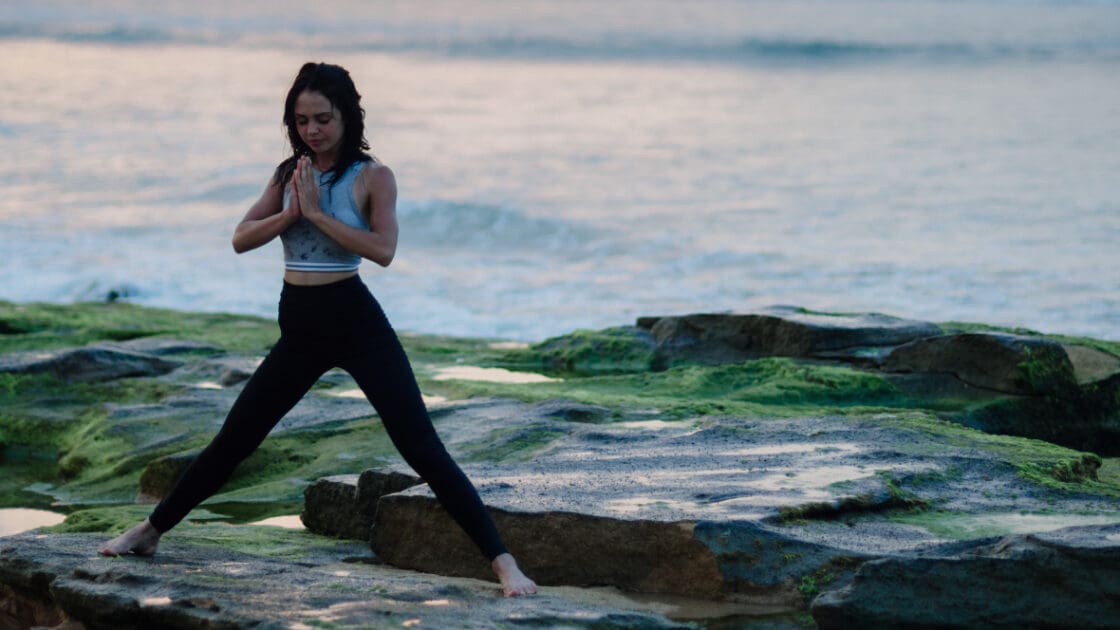Clearing Up These 7 Yoga Misconceptions Will Make You Want to Get Your Om On

From the outside looking in yoga can seem a bit mysterious, exotic, and even intimidating. But once you hit your mat, you’ll find a lot of what you thought prior to practicing wasn’t true at all. You don’t have to twist yourself into a pretzel to be a yogi. And you don’t have to be rich. Come to think of it, many of our notions about this practice tend to be yoga misconceptions, so let’s clear a few of them up.
1. You need to do cardio in addition to your practice.
According to Ashleigh Sergeant, 20-year yoga veteran and head of yoga content for Gaia.com, the most important thing to remember is that everybody is totally different and as a result, every yoga practice is totally different. Some people require cardio and some don’t. Some do and then they don’t. It could change throughout your practice. Maybe you’re one who enjoys sweating it out in a hot vinyasa class, which means that adding in additional cardio might not be necessary. Or maybe you’re addicted to deep stretch or Yin forms of yoga with little or no movement. In this case, adding in some cardio could be necessary. It’s all about being grounded and connected enough in your own practice to know where you fall on the spectrum.
2. You have to go to a yoga studio.
Ultimately, says Sergeant, it’s about working with your own body whether or not you’re at a studio.
“It’s about learning to listen daily,” says Sergeant. “For many people gaining an intuitive practice that’s closely tied with what you need can’t happen if you’re constantly depending on a teacher to tell you what to do.”
It’s great to be inspired by a studio class and then add that new material into your home practice. Traditionally, classes consisted of one teacher and one student working in alignment. In fact, Sergeant was drawn to the practice because it wasn’t a team sport. “I liked the idea and doing something that was mostly independent,” she says.
3. Yoga should never be painful.
Well, that depends on what you consider painful, says Sergeant. Of course there should never be any shooting pain, but a sense of discomfort may be what it takes to progress.
“Yoga teaches you to cultivate discernment,” says Sergeant. “You may feel some discomfort in the form of shaking or tightness in the muscles. Sometimes certain poses may even make you feel angry, like I need to get out of this. That’s just working toward your edge.”
Sergeant says that there are two simple ways to tell whether you’ve gone too far in a pose and are risking injury.
-Can you breathe deeply in the pose? If you can no longer breathe and you feel like you’re forcing yourself into a position and holding your breath, pull back.
-Pinpointed pain is bad. When pain is really localized and sharp, it’s time to pull back.
4. Yoga is just about the mat.
Yoga is so much more than what happens in the 60 to 90 minutes you spend on your mat. In many yoga traditions, the entire purpose of your physical practice was to prepare the body to sit in meditation. The word yoga means to yoke or connect the body, mind, and spirit.
“It’s a state of awareness,” says Sergeant. “We move through a series of sequences and breathing techniques in order to synch the mind and the body up. Your practice should lead you toward an extended state of peace.”
5. You have to be flexible.
You don’t have to twist yourself into a pretzel to be a yogi. Sometimes in yoga being flexible can even be a hindrance because you have to go so much further to find any sensation, which can make you more susceptible to injury. The bottom line, says Sergeant, it’s about getting what you need out of your practice. For some of us that means gaining flexibly and for others that means gaining strength. The body is much healthier when strength and flexibility are in balance.
6. It’s expensive.
This is the furthest thing from the truth, says Sergeant, who was drawn to yoga because it didn’t require anything.
“Just like everything else in our capitalist society, yoga has been commercialized,” she says. “But in fact I was drawn to yoga because you don’t need anything. You don’t even need a mat.”
You don’t have to go to a studio if you can’t afford it and you certainly don’t need $90 yoga pants to practice. Props like bolsters and blankets can be fun but they aren’t necessary. And fancy yoga retreats won’t help you connect with the divine. In the end, the most important thing is that you practice often and ensure that the point of your practice is that you connect within.
7. You’re joining a cult.
Some people get really turned off by chanting, kirtan, or even saying ‘Om’ — and that’s okay. There are literally infinite pathways of yoga. For some, yoga is just prayer and chanting, and for others it’s about being more connected with yourself. Again, it’s all about meditation. Chanting does have some benefits because it’s known to inspire connection but if it makes you uncomfortable, don’t feel like it has to be a part of your practice.
Related on Organic Authority
The 3 Breathing Techniques That’ll Take Your Yoga Practice to New HeightsThis Ancient Ritual Quiets the Mind and Opens the Heart, Every Time
The Crazy Link Between an Awesome Sex Life and Your Chakra System

